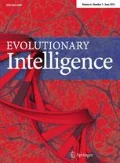Abstract
This paper proposes several modifications to existing hybrid evolutionary algorithms in grid-based puzzles, using a-priori probabilities of 0/1 occurrence in binary encodings. This calculation of a-priori probabilities of bits is possible in grid-based problems (puzzles in this case) due to their special structure, with the solution confined into a grid. The work is focused in two different grid-based puzzles, the Japanese puzzles and the Light-up puzzle, each one having special characteristics in terms of constraints, which must be taken into account for the probabilities of bit calculation. For these puzzles, we show the process of a-priori probabilities calculation, and we modify the initialization of the EAs to improve their performance. We also include novel mutation operators based on a-priori probabilities, which makes more effective the evolutionary search of the algorithms in the tackled puzzles. The performance of the algorithms with these new initialization and novel mutation operators is compared with the performance without them. We show that the new initialization and operators based on a-priori probabilities of bits make the evolutionary search more effective and also improve the scalability of the algorithms.












Similar content being viewed by others
References
Khoo A, Zubek R (2002) Applying inexpensive AI techniques to computer games. IEEE Intell Syst 17(4):48–53
Lucas SS, Kendall G (2006) Evolutionary computation and games. IEEE Comput Intell Mag 1(1):10–18
Kendall G, Parkes A, Spoerer K (2008) A Survey of NP-Complete Puzzles. Int Comput Games Assoc J 31(1):13–34
Ortiz-García E, Salcedo-Sanz S, Pérez-Bellido AM, Portilla-Figueras A, Yao X (2008) Solving very difficult Japanese puzzles with a hybrid evolutionary-logic algorithm. Lect Notes Comput Sci 5361:360–369
Batenburg B, Kosters W (2004) A discrete tomography approach to Japanese puzzles. In: Proceedings of the Belgian-Dutch conference on artificial intelligence, pp 243–250
Wiggers W (2004) A comparison of a genetic algorithm and a depth first search algorithm applied to Japanese nonograms. In: Proceedings of the 1st Twente Student conference on IT, pp 1–6
Salcedo-Sanz S, Portilla-Figueras J, Pérez.Bellido A, Ortiz-García E, Yao X (2007) Teaching advanced features of evolutionary algorithms using Japanese puzzles. IEEE Trans Edu 50(2):151–155
Conceptis Puzzles Inc (2009) http://www.conceptispuzzles.com
Ueda N, Nagao T (1996) NP-completeness results for nonograms via parsimonious reductions. Internal Report, University of Tokyo, Computer Science Department
Benton J, Snow R, Wallach N (2006) A combinatorial problem associated with nonograms. Linear Algebra Appl 412(1):30–38
Nikoli puzzles (2009) http://www.nikoli.co.jp/en/puzzles/light_up/
Ortiz-García EG, Salcedo-Sanz S, Pérez-Bellido ÁM, Portilla-Figueras A (2007) A Hybrid Hopfield Network-Genetic Algorithm Approach for the Light-up Puzzle. In: Proceedings of the IEEE conference on evolutionary computation, pp 1403–1407
Benchmark puzzles (2009) http://www.homepages.cwi.nl/∼aeb/games/jpuzzlegraded/index.html
Dorant M (2007) A begginer’s guide to solving picture forming logic puzzles, http://www.conceptispuzzles.com/index.aspx?uri=info/article/79
Duncan G (1999) Puzzle solving. B.Sc. degree final project Report, University of York, Computer Science Department
Simpson S (2006) http://www.comp.lancs.ac.uk/computing/users/ss/nonogram/index.html
Batenburg KJ, Kosters WA (2009) Solving nonograms by combining relaxations. Pattern Recognition (in press)
Salcedo-Sanz S, Ortiz-García E, Pérez.Bellido A, Portilla-Figueras J, Yao X (2007) Solving Japanese puzzles with heuristics. In: IEEE symposium on computational intelligence and games, Honolulu (USA), April
Ortiz-García E, Salcedo-Sanz S, Leiva-Murillo JM, Pérez.Bellido A, Portilla-Figueras J (2007) Automated generation and visualization of picture-logic puzzles. Comput Graph 31:750–760
Salcedo-Sanz S, Ortiz-García EG, Prez-Bellido AM, Portilla-Figueras JA (2008) Using a bank of binary Hopfield networks as constraints solver in hybrid algorithms. Neurocomputing 71:1061–1068
Hopfield JJ (1982) Neurons and physical systems with emergent collective computational abilities. Proc Natl Acad Sci USA 79:2554–2558
Shrivastava Y, Dasgupta S, Reddy SM (1992) Guaranteed convergence in a class of Hopfield networks. IEEE Trans Neural Netw 3:951–961
Light-up puzzle page (2009) http://www.puzzle-Light-up.com/
Acknowledgments
This work has been partially supported by Universidad de Alcalá, Comunidad de Madrid and Ministerio de Educación of Spain under grants number CCG08-UAH/AMB-3993 and TEC2006-07010. E. G. Ortiz-García is supported by Universidad de Alcalá, under the University F.P.I. grants program. Á. M. Pérez-Bellido is supported with a doctoral fellowship by the European Social Fund and Junta de Comunidades de Castilla la Mancha, in the frame of the Operating Programme ESF 2007-2013.
Author information
Authors and Affiliations
Corresponding author
Rights and permissions
About this article
Cite this article
Ortiz-García, E.G., Salcedo-Sanz, S., Pérez-Bellido, Á.M. et al. Improving the performance of evolutionary algorithms in grid-based puzzles resolution. Evol. Intel. 2, 169–181 (2009). https://doi.org/10.1007/s12065-009-0030-3
Received:
Revised:
Accepted:
Published:
Issue Date:
DOI: https://doi.org/10.1007/s12065-009-0030-3




